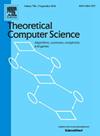对于Parikh矩阵,三进制仍然很好
IF 1
4区 计算机科学
Q3 COMPUTER SCIENCE, THEORY & METHODS
引用次数: 0
摘要
这项工作的重点是研究Parikh矩阵,重点是两个具体问题。在我们演示的第一部分中,我们展示了Dick在2021年提出的一个猜想仅适用于三元字母表,同时为较大的字母表提供了反例。特别地,我们证明了在3个字母的情况下,唯一的可区分性类型是平凡的。本文的第二部分建立在Parikh矩阵的概念上,用于单词的投影,在本工作的前一部分中讨论过,并回答了Atanasiu等人在2022年提出的关于共享同余类的单词之间的最小汉明距离的问题,再次以三元字母表为例。本文章由计算机程序翻译,如有差异,请以英文原文为准。
Ternary is still good for Parikh matrices
The focus of this work is the study of Parikh matrices with emphasis on two concrete problems. In the first part of our presentation we show that a conjecture by Dick at al. in 2021 only stands in the case of ternary alphabets, while providing counterexamples for larger alphabets. In particular, we show that the only type of distinguishability in the case of 3-letter alphabets is the trivial one. The second part of the paper builds on the notion of Parikh matrices for projections of words, discussed in the former part of this work, and answers, once more in the case of a ternary alphabet, a question posed by Atanasiu et al. in 2022 with regards to the minimal Hamming distance in between words sharing a congruency class.
求助全文
通过发布文献求助,成功后即可免费获取论文全文。
去求助
来源期刊

Theoretical Computer Science
工程技术-计算机:理论方法
CiteScore
2.60
自引率
18.20%
发文量
471
审稿时长
12.6 months
期刊介绍:
Theoretical Computer Science is mathematical and abstract in spirit, but it derives its motivation from practical and everyday computation. Its aim is to understand the nature of computation and, as a consequence of this understanding, provide more efficient methodologies. All papers introducing or studying mathematical, logic and formal concepts and methods are welcome, provided that their motivation is clearly drawn from the field of computing.
 求助内容:
求助内容: 应助结果提醒方式:
应助结果提醒方式:


